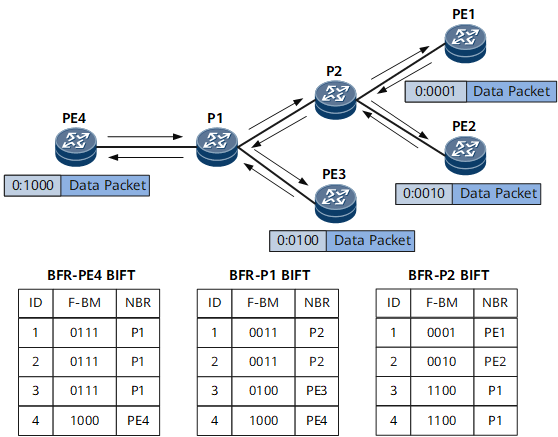BIER Forwarding Plane Fundamentals
Bit Index Forwarding Table Establishment
In a BIER domain, each edge node in a BIER sub-domain must be configured with a BFR-ID that is unique in the sub-domain.
BFR-IDs in the BIER sub-domain, together with other information (for example, nodes' IP addresses), are flooded through the IGP. Each node on the network generates its BIER forwarding information. After receiving a BIER packet carrying a BitString, each node performs packet replication and forwarding according to the BitString in the packet.

- The ID refers to a BFR-ID. When the next hop of a BFR-ID is reached, the record needs to be queried.
- F-BM is short for Forwarding BitMask. It indicates the set of BIER domain edge nodes that are reachable through the next hop after packets are replicated and sent to the next hop.
- NBR is short for neighbor. It indicates the next hop neighbor of a BFR-ID.
BIER Multicast Traffic Forwarding
As shown in Table 1, when PE4 needs to send the multicast traffic (S1, G1) to PE1, PE2, and PE3, PE4 encapsulates the BitString (0111). The multicast traffic is sent as follows.
Link |
BitString in the Packet |
Description |
|---|---|---|
PE4 → P1 |
BitString(0111) |
In the packet sent from PE4 to P1, the BitString contains the set of BFR-IDs of PE1, PE2, and PE3. |
P1 → PE3 |
BitString(0100) |
In the packet sent from P1 to PE3, the BitString contains the BFR-ID of PE3. |
P1 → P2 |
BitString(0011) |
In the packet sent from P1 to P2, the BitString contains the set of BFR-IDs of PE1 and PE2, with the BFR-ID of PE3 removed. |
P2 → PE1 |
BitString(0001) |
In the packet sent from P2 to PE1, the BitString contains the BFR-ID of PE1. |
P2 → PE2 |
BitString(0010) |
In the packet sent from P2 to PE2, the BitString contains the BFR-ID of PE2. |